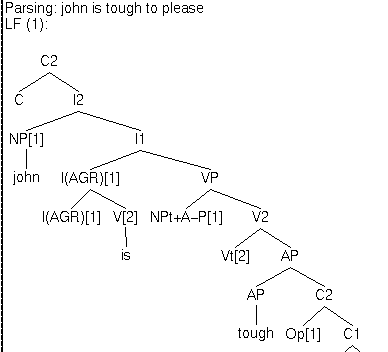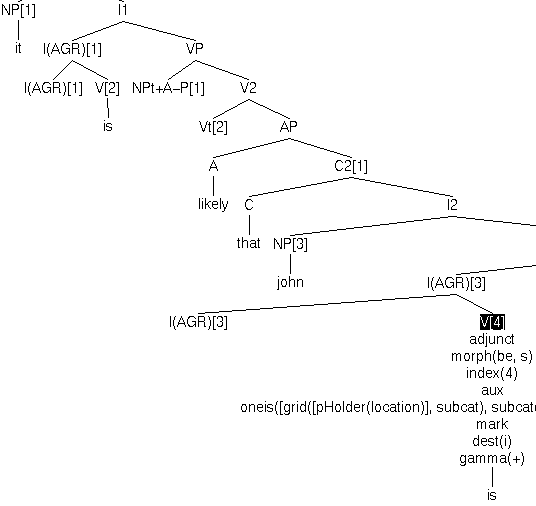
xbar2.pl as follows:
spec(v2,np).Needed to make the new position an A-position:
rhs [np(NP),v2(V2)] ordered specInitial app_goals [aPos(NP)].
thetaConfig(IP,Role,Subject) :- % [IP Subject [I1 IO VP]] cat(IP,i2), VP complement_of IP, Subject specifier_of IP, externalRole(VP,Role).We added [Spec,VP] and [Spec,AP] as the replacement theta configuration:
thetaConfig(VP,Role,Subject):- %thetaConfig (VP... is new code (cat(VP,vp) ; cat(VP,ap)), \+ adjoined(VP), Subject specifier_of VP, externalRole(VP,Role).Added new code for
thetaRelevant(X). Category that is theta
relevant is extended to VP.
thetaRelevant(X):- cat(X,VP). %new code

Reason was that subcategorizes_for/2 doesn't work
properly when it is presented with a [VP Spec [V' V AP]]
structure. Previously it was only given something like
[VP V AP]]. It's job is to pick out the AP
phrase.
In file principles14.pl:
inheritsFeature(X,F) :- X has_feature F -> true % ; (X subcategorizes_for Y ; (Y complement_of X -> inheritsFeature(Y,F) ; adjoined(X,_,LowerX), inheritsFeature(LowerX,F)).Who called
inheritsFeature/2:
externalRole(XP,Role) :- \+ inheritsFeature(XP,blockTheta), inheritsFeature(XP,grid([Role],_)). % external Role
blockTheta is no
longer a feature of the passive verb, but a feature that is assigned
downwards to the verb it subcategorizes for.
In file lexiconE.pl, we have:
lex(be,v,[morph(be,[]),aux, oneof(_,[ ... [subcat(vp$[morph(_,ed(2)),grid([_],[_|_]), not(noCasemark(+))],[blockTheta,noCasemark(+)])], ...])]).instead of:
[subcat(vp$[morph(_,ed(2)),grid([_],[_|_]), not(noCasemark(+))],[noCasemark(+)]), blockTheta],
Idea is that the main verb should not assign the theta role (normally
assigned to the subject position). The blockTheta feature
tells the main verb not to do this:
thetaConfig(VP,Role,Subject):- %thetaConfig (VP... is new code cat(VP,vp), \+ adjoined(VP), Subject specifier_of VP, externalRole(VP,Role).See definition of
externalRole/2 above
expletiveLinking so the VP internal subject
links to the object instead of the IP subject.
expletiveLinking in_all_configurations CF where linkConfig(CF,Subject,XP) then expletiveLink(Subject,XP). linkConfig(VP,Subj,XP) :- expletiveSubjChain(VP,Subj,C), linkPhrase(VP,C,XP).
expletiveSubjChain(VP,Subj,C) :-
specVP(VP,X),
(partOfChain(X)
-> baseTrace(X),
headOfChain(Subj,X),
expletive(Subj,C)
; expletive(X,C),
Subj = X).
specVP(VP,Spec) :-
\+ adjoined(VP),
cat(VP,vp),
Spec specifier_of VP.
Note here that the else-clause in expletiveSubjChain/2 is
never used in English. Previously, the subject was base-generated in
[Spec,IP], so the then-clause was only used for long-distance
expletive linking, e.g. there seems to be a man in the room.
Now, the then-clause is always used.
Problem: Massive overgeneration for there seems to be a man in the room. See:

Second problem with expletive linking: Expletive linking not adjoined:
can link to the subject of any category.
Some changes in Expletive Linking:
added specMax predicate in expletiveSubjChain(XP,Subj,C)
expletiveSubjChain (XP,Subj,C):-
specMax(XP,X),
(partOfChain (X)
-> baseTrace (X),
headOfChain (Subj,X),
expletive (Subj,C)
; expletive (X,C(,
Subj = X).
% should work for VP, AP...
% need to eliminate the \+ adjoined/1 restriction for
% [AP [AP Spec [A1 tough] [C2..]]]
% consequence: we consider all segments now => possible multiple linking
specMax(XP,Spec):-
% \+ adjoined(XP), commented out adjoined code
cat (XP,C),
max (C),
Spec specifier_of XP.
externalRole/2 otherwise
matrix auxiliary inherits role pHolder(location)
all the way down the subcategorization chain:

We modify the call to inheritsFeature/2 so that
ExtR is a pure variable. Since the theta grid for
likely is grid([],[proposition]),
ExtR will be instantiated to [], and
therefore the code will not look any further down the tree.
externalRole(XP,Role) :- \+ inheritsFeature(XP,blockTheta), inheritsFeature(XP,grid(ExtR,_)), % external Role ExtR = [Role].
I am proud of John.
I am proud that John is here.
This is because genitive was being assigned to the SPEC. assignsInherentCase(a,NP,gen):- NP has_feature compl.
partOfNonargumentChain(NP)
.
% Need to account for
% [IP it [nonarg(+)] [VP t [V2 ..PRO..]]]
% where t m-commands PRO and t is part of a chain headed by 'it':
partofNonargumentChain (NP):-
NP has_feature nonarg (+)
-> true
; partofChain (NP),
headOfChain(Head,NP),
Head has_feature nonarg(+).
%%% Lowering Filter
%%%
%%% Prohibition against chains with lowering
loweringFilter parser_operation 'Lowering Filter'
with_components
io given_by [ss],
dep given_by resolveTraces,
controlType given_by filter,
%optional...
sCueFilter.
loweringFilter in_all_configurations CF where
isTrace (CF), downPath (CF,Path) then Path = [].
Also changed parser, dispalay, defaults (of parser) to include lowering
filter. Paser is now j5c parser. This is now included in the defaults
file.

Also Binding problem:

Implementation of Larson's analysis of double object constructions
will fix this.
Observations
1. The distribution of "each of the NP" and "NP each" is different,
with the former being totally free and the latter not. Examples
of the freedom of the former:
a) Each of the boys left.
b) I saw each of the boys.
c) I gave a book to each of the boys.
The third one of these allows "each" essentially to have scope over the
implicit determiner of "a book": i.e. For each of the boys, I gave him
his book.
2. The distribution of the stranding of "each" in the "NP each" construction
follows the distribution of "NP each" in the base itself. That is,
if "NP each" is possible in a given position in the base form, then
the stranding of "each" is possible in that same form, with only slight
degradation. But "NP each" is not possible in every position. Some relevant
position are:
a) VP internal subject postion: "NP each" generated and "each" strands.
Ex.: The boys may each talk to Bill.
b) AP internal subject position: "NP each" generated and "each" strands.
Ex.: The boys are each intelligent.
c) VP internal position after "to": "each" strands.
Ex.: The boys seem to each like Mary.
d) Subject position of complement under raising verb. Good, maybe very
slightly odd.
Ex.: The boys seem each to like Mary.
e) Object postion, no other arguments. Stranding totally out. Also, base
form totally out. (As noted earlier, the stranding follows the base form
in ungrammaticality: it is really a question of whether the base form
is grammatical.)
Ex.: *The boys were hit t each.
*The boys were hit t each quickly.
f) Object position, another PP argument. Stranding marginal (??).
Also, base form marginal (one follows the other). Base form slightly
better than stranded form.
Ex.: ??I put the books each on the shelf.
?*The books were put t each on the shelf.
??I gave the books each to Mary.
?*The books were given t each to Mary.
? I sent the books each to Mary.
??The books were sent t each to Mary.
g) First Object position in the V NP1 NP2 construction. Perfect, or close
to it.
Ex.: I gave the boys each a book.
The boys were given t each a book.
I bought the boys each a book.
The boys were bought t each a book.
3. Note that "each of the boys" and "the boys each" have very differing
scopes, with the former able to take scope much more freely:
a) I gave a book to each of the boys.
b) *I gave a book to the boys each.